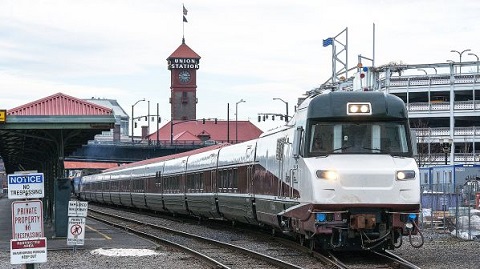The taxpayers pay more for each ride than the rider does.
 Editor’s note: This is the third in a multi-part series on the budget for the State of Oregon and where possible efficiencies can be found.
Editor’s note: This is the third in a multi-part series on the budget for the State of Oregon and where possible efficiencies can be found.
For years, fiscal conservatives in Oregon have railed (no pun intended) against inter-city passenger rail in Oregon. This isn't light rail, like you find in Portland, nor is is Amtrak, which has grey cars with the red and blue logo running north and south where it can squeeze on on freight rail tracks. No, this is inter-city passenger rail and the State of Oregon owns two train sets called Amtrak Cascades, which are kind of cream colored with a maroon and green swoosh on them. It's meant to carry passengers between cities, hence, intercity passenger rail.
These trains run from Eugene to Portland several times a day, and have been criticized for being highly subsidized.
Ridership is flat -- a fact that may be driven by the not-so-great
on-time performance of the system. In its defense, since freight trains get priority on the use of the rails, the Amtrak Cascades lines get pulled over to let freight through, but this single fact means that the train cannot be depended upon as a means of commuting -- at least not to a job where you are expected to show up on time. Ridership tends to be limited to Portland/Salem/Eugene shopping tourism, as far as that can go.
After the 2017 Transportation Package passed, Democrats made the general fund rail subsidy go away and turned it into an
other funds allocation. The source of this money is a little bit cryptic and needs explanation. Remember, that general fund allocations are the first ones that the budget cutters go after -- especially if they aren't highly necessary core services, like public safety or indigent health care. For years, the subsidy to intercity passenger rail was listed as a general fund items and the budget dogs barked incessantly at it. More recently, the source of funds was changed to be from the "Lawnmower Fund" -- an "other fund" source -- possibly in an attempt to get the budget dogs to back off.
What is the "Lawnmower Fund"? This is more formally known as the Transportation Operating Fund. In Oregon, the state gas tax, which is constitutionally dediacated to the Highway Fund is collected at the rate of $0.36 per gallon of gasoline or diesel. Except, if you're not going to use the gasoline or diesel to operate a vehicle on the highway, you can fill out some paperwork and not pay the tax. Most people don't know this, or even if they do know, they don't care to bother with the paperwork to save less than a buck, so they just pay the tax on their can of lawnmower gas. The state estimates the amount of overpayment on this tax and diverts it from the Highway Fund and into the Transportation Operating Fund, which the Legislature can use as a slush fund for whatever it wants.
In this case, the money was slushed into Amtrak Cascades to the tune of $10 million. A re-thinking of this program could put that money in service of a better use. The Oregon Department of Transportation reports ridership for 2019 at 103,185 riders. Dividing $10 million by that number means that each ride is subsidized to the tune of about $97 per ride, which is far more than the cost of a ticket.
Savings: $10 million biennially
--Staff Reports| Post Date: 2020-07-10 08:00:00 | Last Update: 2020-07-01 21:25:50 |







 Editor’s note: This is the third in a multi-part series on the budget for the State of Oregon and where possible efficiencies can be found.
Editor’s note: This is the third in a multi-part series on the budget for the State of Oregon and where possible efficiencies can be found.